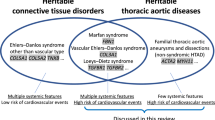Abstract
Objective
Hyper-IgE syndrome (HIES) is a rare primary immunodeficiency caused by autosomal dominant STAT3 mutations resulting in recurrent infections and connective tissue abnormalities. Coronary artery abnormalities have been reported infrequently. We aimed to determine the frequency and characteristics of coronary artery abnormalities.
Design
STAT3-mutated HIES patients (n = 38), ranging in age from 8 to 57 years, underwent coronary artery imaging by computed tomography or magnetic resonance imaging. Images were evaluated for tortuosity, dilation, and aneurysm. Charts were reviewed for cardiac risk factors. To allow blinded image interpretation, an age- and gender-matched non-HIES group was also evaluated (n = 33).
Results
Coronary artery tortuosity or dilation occurred in 70% of HIES patients, with aneurysms present in 37%, incidences much higher than in the literature and in our non-HIES group, in which 21% had tortuosity or dilation and 3% had aneurysms. Hypertension was more common in the HIES group than in the general population and was associated with vessel abnormalities. Atherosclerosis was uncommon and mild.
Conclusions
Coronary artery aneurysms and tortuosity are common in HIES, despite a paucity of atherosclerosis, suggesting that STAT3 plays an integral role in human vascular remodeling and atherosclerosis.



Similar content being viewed by others
References
Holland SM, DeLeo FR, Elloumi HZ, Hsu AP, Uzel G, Brodsky N, et al. STAT3 mutations in the hyper-IgE syndrome. New Engl J Med. 2007;357:1608–19.
Minegishi Y, Saito M, Tsuchiya S, Tsuge I, Takada H, Hara T, et al. Dominant-negative mutations in the DNA-binding domain of STAT3 cause hyper-IgE syndrome. Nature. 2007;448:1058–62.
Freeman AF, Holland SM. The hyper-IgE syndromes. Immunol Allergy Clin North Am. 2008;28:277–91.
Freeman AF, Collura-Burke CJ, Patronas NJ, Ilcus LS, Darnell D, Davis J, et al. Brain abnormalities in patients with hyperimmunoglobulin E syndrome. Pediatrics. 2007;119:e1121–5.
Alomar-Melero E, Martin TD, Janelle GM, Peng YG. Unusual giant right coronary artery aneurysm resembles an intracardiac mass. Anesth Analg. 2008;107(4):1161–2.
Gharib AM, Pettigrew RI, Elagha A, Hsu A, Welch P, Holland SM, et al. Coronary abnormalities in Hyper-IgE recurrent infection syndrome: depiction at coronary MDCT angiograph. AJR. 193;478–81.
Ling JC, Freeman AF, Gharib AM, Arai AE, Lederman RJ, Rosing DR, et al. Coronary artery aneurysms in patients with hyper IgE recurrent infection syndrome. Clin Immunol. 2007;122:255–8.
Young TY, Jerome D, Gupta S. Hyperimmunoglobulinemia E syndrome associated with coronary artery aneurysms: deficiency of central memory CD4+ T cells and expansion of effector memory CD4+ T cells. Ann Allergy Asthma Immunol. 2007;98(4):389–92.
Olive M, Mellad JA, Beltran LE, Ma M, Cimato T, Noguchi AC, et al. p21Cip1 modulates arterial wound repair through the stromal cell-derived factor-1/CSCR4 axis in mice. J Clin Invest. 2008;118(6):2050–61.
Gharib AM, Ho VB, Rosing DR, Herzka DA, Stuber M, Arai AE, et al. Coronary artery anomalies and variants: technical feasibility of assessment with coronary MR angiography at 3T. Radiology. 2008;247:220–7.
Datta J, White CS, Gilkeson RC, Meyer CA, Kansal S, Jani ML, et al. Anomalous coronary arteries in adults: depiction at multi-detector row CT angiography. Radiology. 2005;235:812–8.
Arnold R, Ley S, Ley-Zaporozhan J, Eichhorn J, Schenk JP, Ulmer H, et al. Visualization of coronary arteries in patients after childhood Kawasaki syndrome: value of multidetector CT and MR imaging in comparison to conventional coronary catheterization. Pediatr Radiol. 2007;37(10):998–1006.
Greil GF, Stuber M, Botnar RM, Kissinger KV, Geva T, Newburger JW, et al. Coronary magnetic resonance angiography in adolescents and young adults with Kawasaki disease. Circulation. 2002;105:908–11.
Kim WY, Danias PG, Stuber M, Flamm SD, Plein S, Nagel E, et al. Coronary magnetic resonance angiography for the detection of coronary stenoses. New Engl J Med. 2001;345:1863–9.
Miller JM, Rochitte CE, Dewey M, Arab-Zadeh A, Niinuma H, Gottlieb I, et al. Diagnostic performance of coronary angiography for the detection of coronary stenoses. New Engl J Med. 2008;359:2324–36.
Garcia MJ, Lessick J, Hoffmann MH. Accuracy of 16-row multidetector computed tomography for the assessment of coronary artery stenosis. JAMA. 2006;296:403–11.
Executive summary of the Third Report of the National Cholesterol Education Program (NCEP) expert panel on detection, evaluation, and treatment of high blood cholesterol in adults (adult treatment panel III). JAMA 2001;285:2486–97
Hoffmann MH, Shi H, Schmitz BL, Schmid FT, Lieberknecht M, Schulze R, et al. Noninvasive coronary angiography with multislice computed tomography. JAMA. 2005;293:2471–8.
Bullitt E, Gerig G, Pizer SM, Lin W, Aylward SR. Measuring tortuosity of the intracerebral vasculature from MRA images. IEEE Trans Med Imaging. 2003;22(9):1163–71.
Cohen P, O’Gara PT. Coronary artery aneurysms: a review of the natural history, pathophysiology, and management. Cardiol Rev. 2008;16(6):301–4.
Swaye PS, Fisher LD, Litwin P, Vignola PA, Judkins MP, Kemp HG, et al. Aneurysmal coronary artery disease. Circulation. 1983;67:134–8.
Burns CA, Cowley MJ, Wechsler AS, Vetrovec GW. Coronary aneurysms: a case report and review. Cathet Cardiovasc Diagn. 1992;27:106–12.
Judge DP, Dietz HC. Marfan’s syndrome. Lancet. 2005;366:1965–76.
Loeys BL, Schwarze U, Holm T, Callewaert BL, Thomas GH, Pannu H, et al. Aneurysm syndromes in the TGF-beta receptor. New Engl J Med. 2006;355:788–98.
Watanabe A, Takashi S. The vascular type of Ehlers–Danlos syndrome. J Nippon Med Sch. 2008;75(5):254–61.
Zegers ES, Meursing BTJ. AJM Oude Ophuis. Coronary tortuosity: a long and winding road. Neth Heart J. 2007;5:191–5.
Callewaert BL, Willaert A, Kerstjens-Frederikse WS, DeBacker J, Devriendt K, Albrecht B, et al. Familial arterial tortuosity syndrome: clinical and molecular findings in 12 newly identified families. Hum Mutat. 2008;29:150–8.
Gavin PJ, Crawford SE, Shulman ST, Garcia FL, Rowley AH. Systemic arterial expression of matrix metalloproteinases 2 and 9 in acute Kawasaki disease. Arterioscler Thromb Vasc Biol. 2003;23:576–81.
Pay S, Abbasov T, Erdem H, Musabak U, Simsek I, Pekel A, et al. Serum MMP-2 and MMP-9 in patients with Behcet’s disease: do their higher levels correlate to vasculo-Behcet’s disease associated with aneurysm formation? Clin Exp Rheum. 2007;25(4 Supplement 45):S70–5.
Senzaki H. The pathophysiology of coronary artery aneurysms in Kawasaki disease: role of matrix metalloproteinases. Arch Dis Childhood. 2006;91:847–51.
Dogan A, Tuzun N, Turker Y, Akcay S, Kaya S, Ozaydin M. Matrix metalloproteinases and inflammatory markers in coronary artery ectasia: their relationship to severity of coronary artery ectasia. Coron Artery Dis. 2008;19(8):559–63.
Ikonomidis JS, Jones JA, Barbour JR, Stroud RE, Clark LL, Kaplan BS, et al. Expression of matrix metalloproteinases and endogenous inhibitors within ascending aortic aneurysms of patients with Marfan syndrome. Circulation. 2006;114(1 Suppl):I365–70.
Kang HS, Kim SK, Cho BK, Kim YY, Hwang YS, Wang KC. Single nucleotide polymorphisms of tissue inhibitor of metalloproteinase genes in familial moyamoya disease. Neurosurgery. 2006;58(6):1074–80.
Lamblin N, Bauters C, Hermant X, Lablanche JM, Helbecque N, Amouyel P. Polymorphisms in the promoter regions of MMP-2, MMP-3, MMP-9, and MMP-12 genes as determinants of aneurysmal coronary artery disease. J Am Coll Cardiol. 2002;40:43–8.
Scott RM, Smith ER. Moyamoya disease and moyamoya syndrome. New Engl J Med. 2009;360(12):1226–37.
Schroer N, Pahne J, Walch B, Wickenhauser C, Smola S. Molecular pathobiology of human cervical high-grade lesions: paracrine STAT3 activation in tumor-instructed myeloid cells drives local MMP-9 expression. Cancer Res. 2011;71:87–97.
Song Y, Qian L, Song S, et al. Fra-1 and Stat3 synergistically regulate activation of MMP-9 gene. Mol Immunol. 2008;45:137–43.
Tsareva SA, Moriggl R, Corvinus FM, Wiederanders B, Schütz A, Kovacic B, et al. Signal transducer and activator of transcription 3 activation promotes invasive growth of colon carcinomas through matrix metalloproteinase induction. Neoplasia. 2007;9(4):279–91.
Xie TX, Wei D, Liu M, et al. Stat3 activation regulates the expression of matrix metalloproteinase-2 and tumor invasion and metasis. Oncogene. 2004;23:3550–60.
Gharavi NM, Alva JA, Mouillesseaux KP, Lai C, Yeh M, Yeung W, et al. Role of the Jak/STAT pathway in the regulation of interleukin-8 transcription by oxidized phospholipids in vitro and in atherosclerosis in vivo. J Biol Chem. 2007;282(43):31460–8.
Zhou X, Li D, Yan W, Li W. Pravastatin prevents aortic atherosclerosis via modulation of signal transduction and activation of transcription 3 (STAT3) to attenuate interleukin-6 (IL-6) action in ApoE knockout mice. Int J Mol Sci. 2008;9:2253–64.
Pleis JR, Lucas JW. Summary Health statistics for U.S. adults: National health interview survey, 2007. National Center for Health Statistics. Vital Health Stat 2009;10(240)
Forsdahl SH, Singh K, Solberg S, Jacobsen BK. Risk factors for abdominal aortic aneurysms: a 7-year prospective study: the Tromso study, 1994–2001. Circulation. 2009;119:2202–8.
Corunz J, Sidoti Pinto C, Tevaearai H, Egger M. Risk factors for asymptomatic abdominal aortic aneurysm. Eur J Public Health. 2004;14:343–9.
Freeman AF, Kleiner DE, Nadiminti H, Davis J, Quezado M, Anderson V, et al. Causes of death in hyper-IgE syndrome. J Allergy Clin Immunol. 2007;119(5):1234–40.
Habashi JP, Judge DP, Holm TM, Cohn RD, Loeys BL, Cooper TK, et al. Losartan, an AT1 antagonist, prevents aortic aneurysm in a mouse model of Marfan syndrome. Science. 2006;312:117–21.
Brooke BS, Habashi JP, Judge DP, Patel N, Loeys B, Dietz HC. Angiotensin II blockade and aortic-root dilation in Marfan’s syndrome. N Engl J Med. 2008;358(26):2787–95.
Acknowledgement
This research was supported by the Intramural Research Programs of the NIAID, NIDDK, and NIH, Bethesda, MD 20892. The views expressed in this article are those of the authors and do not reflect the official policy of the US government.
Elizabeth Mannino Avila was supported by the Clinical Research Training Program, a public–private partnership supported jointly by the NIH and Pfizer (via a grant to the Foundation for NIH from Pfizer).
Author information
Authors and Affiliations
Corresponding author
Additional information
Alexandra F. Freeman and Elizabeth Mannino Avila contributed equally to this manuscript.
Electronic supplementary material
Below is the link to the electronic supplementary material.
ESM 1
(DOC 38 kb)
Rights and permissions
About this article
Cite this article
Freeman, A.F., Avila, E.M., Shaw, P.A. et al. Coronary Artery Abnormalities in Hyper-IgE Syndrome. J Clin Immunol 31, 338–345 (2011). https://doi.org/10.1007/s10875-011-9515-9
Received:
Accepted:
Published:
Issue Date:
DOI: https://doi.org/10.1007/s10875-011-9515-9




